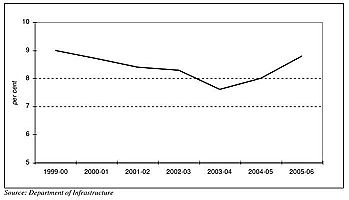Tonight’s Eastern Transport Coalition covered a range of topics as the focus of the group begins to explore key issues that will be relevant for 2008.
The meeting included presentations from the Australian Greens and the Australian Democrats, both of whom are supportive of the need for federal involvement in urban public transport. While Family First, chose not to attend the meeting, I am aware that the Party has announced a policy supporting federal funding for public transport infrastructure.
This is significant, since each of the minor parties represented in Federal Parliament, support the notion of federal involvement in urban public transport. The discussions with the Greens and Democrats were fruitful, with both parties recognising the social, environmental and economic benefits of public transport improvements in the eastern suburbs and suggesting the use of the Senate as a method to raise awareness of the issue within Federal Parliament.
Regardless of the Federal election outcome, announcements such as the $80 million for the grade separation of Springvale Road Nunawading, provide a framework to advocate for partnerships between federal and local governments. This will allow public transport infrastructure to be included within such projects and allow both local and federal governments to hold the State government accountable for much needed public transport improvements.
The Eastern Transport Coalition has also continued its focus on the State Government with a presentation provided in regard to the Transport Legislation Review. The ETC will be authoring a submission that calls on the State Government to prioritise sustainable transport, as well as officially recognise the Government’s own target of increasing public transport modal share to 20% by the year 2020.
The current transport legislation review also draws into question the current lack of integration between VicRoads and the Public Transport Division of the Department of Infrastructure. While legislation may assist in improving outcomes, it will be hampered until physical integration between the Roads Authority (VicRoads) and the Public Transport Division is accomplished. VicRoads, as a statutory authority, enjoys a number of benefits that are not available to the public transport division which sits within the broader Department of Infrastructure.
This is clearly demonstrated in regard to the Maroondah Highway pedestrian crossing between Ringwood Station and Eastland. Despite the fact that the crossing is the most widely used within Maroondah, with over 5000 pedestrians daily, and links the Station with the retail and residential precincts of the Ringwood Transit City, VicRoads has currently been reluctant to improve the crossing.
Physical integration of government departments would follow examples in both Western Australia, with its integrated transport and planning department, and Queensland, which has a Coordinator-General’s department that as a statutory authority provides a whole of government referral authority.
The need for not just legislative integration but departmental integration is clear, with the Commissioner for Environmental Sustainability stating that “A more streamlined approach to land use and transport integration in Victoria would be possible if a single strategic authority were established.”
It is anticipated that both the Legislation Review and the VCEC Inquiry to Melbourne’s Liveability will be a significant focus for the Eastern Transport Coalition in 2008, as we continue to call on the State Government to improve public transport in the eastern suburbs.
